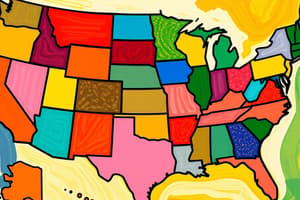Podcast
Questions and Answers
The heel of a chef's knife is the narrowest part of the blade.
The heel of a chef's knife is the narrowest part of the blade.
False (B)
A chef's knife is ideal for chopping small and delicate vegetables.
A chef's knife is ideal for chopping small and delicate vegetables.
False (B)
The curved blade of a chef's knife makes it suitable for precise cuts.
The curved blade of a chef's knife makes it suitable for precise cuts.
False (B)
A chef's knife is suitable for heavy-duty chopping operations.
A chef's knife is suitable for heavy-duty chopping operations.
A chef's knife is designed for cutting only soft vegetables like lettuce or spinach.
A chef's knife is designed for cutting only soft vegetables like lettuce or spinach.
Utility knives are thinner and smaller than paring knives.
Utility knives are thinner and smaller than paring knives.
The sharp tip of a utility knife is designed for cutting through tougher foods like potatoes.
The sharp tip of a utility knife is designed for cutting through tougher foods like potatoes.
Cleavers are used to cut cooked meat into smaller pieces before serving.
Cleavers are used to cut cooked meat into smaller pieces before serving.
Paring knives are only used for cutting, chopping, and slicing fruits and vegetables.
Paring knives are only used for cutting, chopping, and slicing fruits and vegetables.
Cleavers are designed for precise cutting and handling delicate tasks.
Cleavers are designed for precise cutting and handling delicate tasks.
A boning knife is typically used for cutting through raw meat and crushing ginger or garlic bulbs.
A boning knife is typically used for cutting through raw meat and crushing ginger or garlic bulbs.
A filleting knife is stiffer and thicker than a boning knife.
A filleting knife is stiffer and thicker than a boning knife.
A salmon knife is designed for cutting and filleting smaller fish like salmon.
A salmon knife is designed for cutting and filleting smaller fish like salmon.
A bread knife is ideal for cutting through tough and hard objects.
A bread knife is ideal for cutting through tough and hard objects.
A cleaver is often used for processing raw meat and cutting through bone.
A cleaver is often used for processing raw meat and cutting through bone.
A filleting knife is used for cutting through food vertically rather than horizontally.
A filleting knife is used for cutting through food vertically rather than horizontally.
Study Notes
Chef Knife Characteristics
- A chef's knife blade is typically long, wide, and straight in shape.
- The heel of the knife is the broadest part, which gradually tapers up to a point.
- The curved blade design enables the knife to slide back and forth on a cutting board with ease.
Key Uses and Advantages
- The chef knife is ideal for dicing and slicing multiple vegetables simultaneously.
- The large heel section of the knife allows it to withstand more pressure during heavy-duty chopping operations.
- Suitable for cutting bulkier or tougher items, such as potatoes, onions, and carrots.
Studying That Suits You
Use AI to generate personalized quizzes and flashcards to suit your learning preferences.
Description
Learn about the features and uses of a chef's knife, including its curved blade, heel, and chopping capabilities. Understand how it's used for dicing, slicing, and chopping various foods. Test your knowledge of this essential kitchen tool!




